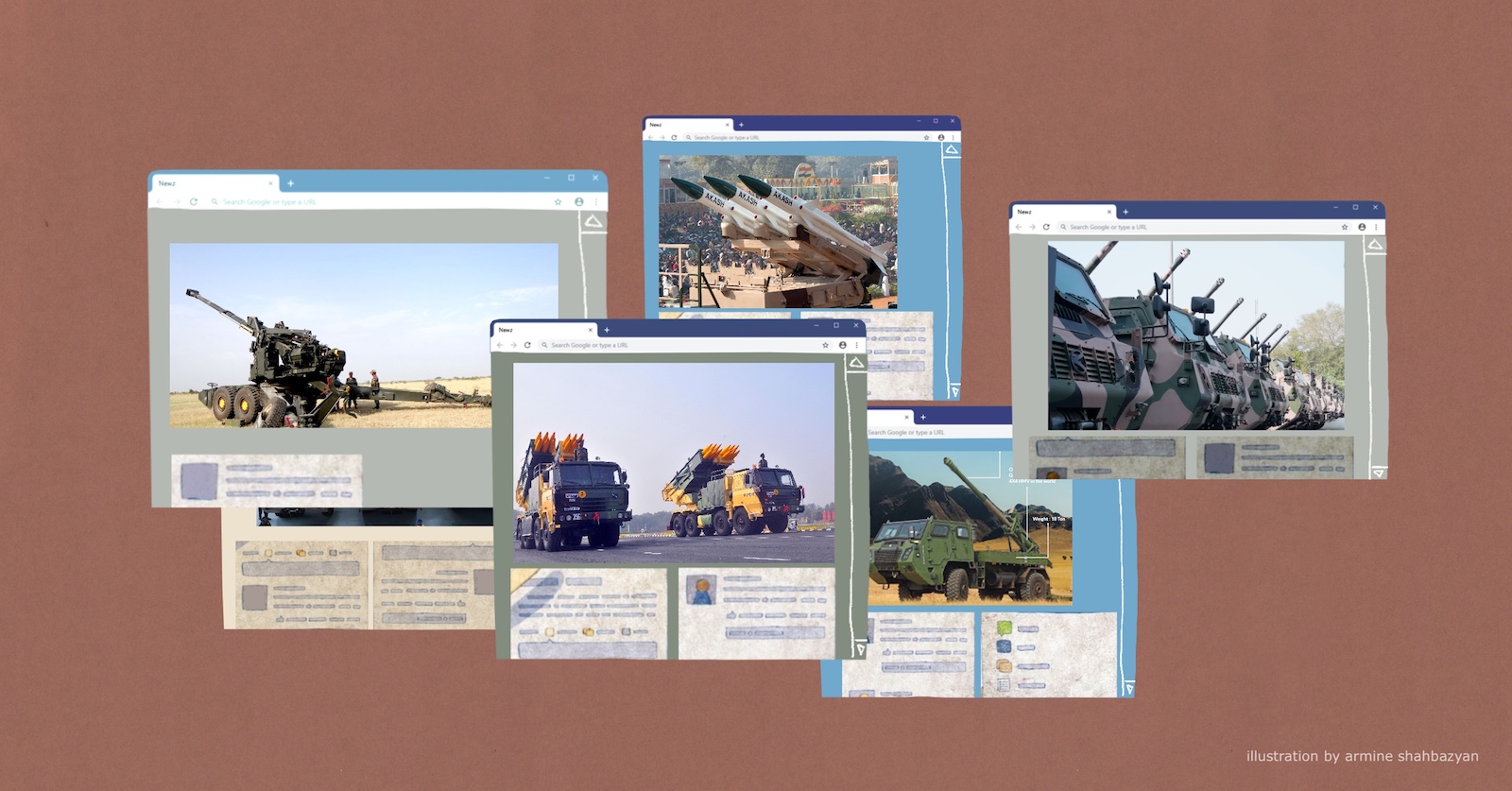
Listen to the article.
For Armenia, India, along with France, has become a primary arms supplier. For India, Armenia is now perhaps the largest foreign customer of its nascent defense industry. While India remains the world’s largest arms importer and the top buyer of French, Russian, and Israeli weapons, the government of Narendra Modi has aimed to decrease its reliance on imports and bolster domestic production. Armenia’s acquisitions have attracted significant attention and excitement within Indian defense circles as they signify the first major export of Indian-produced armaments.
The procurement of Indian weapons by Armenia came under the spotlight in the fall of 2022, almost immediately after the Azerbaijani incursion of mid-September, a watershed moment for the Armenian government’s ongoing drive for security diversification away from Russian dependence. Since then, Armenia has reportedly acquired a substantial amount of Indian armaments, valued at upwards of a billion dollars—an enormous sum for the tiny nation. Much of our knowledge regarding these weapons has been sourced from the Indian media and weapons manufacturers. Various outlets, ranging from respected publications to blogs, have extensively and, often speculatively, covered Armenia’s arms acquisitions, underscoring the need to clarify the details.
Reported Acquisitions
Pinaka MRL
The Times of India reported about Armenian interest in the Pinaka multiple rocket launchers (MRL) in mid-2018, when extensive trials were carried out for a visiting Armenian delegation by the state-run defense R&D agency. The interest from Armenia was acknowledged at the time by Defense Ministry spokesperson Artsrun Hovhannisyan. The actual procurement was reported more than four years later, in late September 2022, and was tacitly confirmed by Pashinyan at the time. According to the Economic Times, Armenia has ordered four Pinaka batteries with each containing six launchers, totaling 24. The contract was estimated at over 20 billion rupees (nearly $245 million).
Satyanarayan Nuwal, chairman of Solar Group, a private ammunition manufacturer, revealed in an interview in October 2022, that Armenia had ordered three types of Pinaka rockets (Mark-I, enhanced, and guided). He said the order is to be completed within two years. According to the Times of India, Solar Group had received an order to export Pinaka rockets worth 3 billion rupees ($36 million) to a European country, which India Today identified as Armenia. Additionally, the Times of India mentioned that the rockets would be delivered within one and a half years. It was also noted that an “order of equal worth has simultaneously gone” to state-owned Munition India Limited (MIL), although it was not clarified whether this pertained to Pinaka rockets or if they were ordered by the same country.
A year later, in October 2023, the state-owned ammunition manufacturer Ordnance Factory Ambajhari officially commenced the export of the first batch of enhanced Pinaka rockets. The recipient was not named, but Indian sources pointed to Armenia as the likely customer.
The three Pinaka rockets, Mark-I, enhanced, and guided, have firing ranges of 37.5 km, 45 km, and 75 km, respectively, placing them between the Soviet-made Grad (20 to 52 km) and Smerch (70 to 90 km or more) rockets. Armenia may have lost as many as 84 MRLs during the 2020 war, mostly Grads. This loss underscores the pressing necessity for Armenia to replenish its stocks and address the post-war asymmetry with Azerbaijan. Notably, the guided Pinaka rocket boasts a high precision of under 60 m. While the Indian military has acquired and deployed the Pinaka, no other country besides Armenia is known to have ordered it yet.
Howitzers
In November 2022, the Indian multinational Bharat Forge announced that its defense subsidiary Kalyani Strategic Systems has been awarded an export order for 155mm artillery guns to a “non-conflict zone”. It said the $155.5 million deal will be executed over a three-year timeframe. Retired Colonel Ajai Shukla then reported in the Business Standard that according to Indian Defense Ministry sources Armenia is the buyer and the order consists of 155 mm/39 caliber self-propelled howitzers. The Print also identified Armenia as the buyer.
There have been conflicting reports about the specific type of these howitzers. Several Indian outlets had initially reported that the order announced by Bharat Forge consisted of 155mm/52 caliber Advanced Towed Artillery Gun Systems (ATAGS). Conversely, in November 2023, the website Indian Defence Research Wing (idrw.org) claimed that Bharat Forge had “confirmed” Armenia’s purchase of 155 mm/39 caliber Multi-terrain Artillery Gun (MArG) howitzers. This dubious and uncorroborated report, which has since been deleted, was cited widely by Armenian outlets, and in the Azerbaijani and Indian media. Idrw.org had earlier reported that an Armenian delegation had observed trials of MArG howitzers in 2022. Another website, Indian Aerospace Defence News (IADN), further reported in March 2023 that Armenia had ordered 21,600 shells for the MArG howitzers, which are set to be completed by September 2024.
Recent remarks from Bharat Forge seem to indicate that Armenia has likely ordered both self-propelled MArG and towed ATAGS howitzers. When asked about the ATAGS order at an investor meeting in August 2023, Bharat Forge’s deputy director Amit Kalyani said that there are two separate orders, “received at a different timeframe.” He hinted at a single customer. In a recent interview, Bharat Forge chairman Baba Kalyani stated that they have already exported six ATAGS howitzers and an additional six “will go this month”, which seems to confirm the earlier report by the Hindu Business Line that Bharat Forge had already shipped six of the nearly 84 ATAGS howitzers to Armenia. Baba Kalyani added that they have received an order for 72 MArG howitzers.
In April 2023, Azerbaijani government-linked media claimed without evidence that Armenia had supposedly used ATAGS howitzers in the recent fighting in Tegh.
The ATAGS and MArG could partially replace the Soviet/Russian-made towed D-20 and D-30 and self-propelled Akatsiya and Gvozdika howitzers in use by the Armenian military. Armenian forces may have lost as many as 250 towed and 29 self-propelled artillery guns during the 2020 war. The ATAGS was designed to replace the Swedish-made FH77B howitzers. According to the developer, the MArG can be deployed in mountainous regions, an obvious advantage for Armenia. Besides Armenia, India has ordered 307 ATAGS guns, while as for the MArG, Armenia remains the sole known customer.
Akash Air Defense System
Armenia’s interest in the Akash air defense systems was first reported in October 2022, when Armenia’s Defense Minister Suren Papikyan visited India to meet with senior defense officials. He also attended a defense expo, where he was hosted by Bharat Dynamics Limited (BDL), a state-controlled company that produces the Akash.
In February 2023, BDL announced an export order worth $255 million subject to government clearances. It did not provide any other details. In its annual report, released in August 2023, BDL said it has received its highest-ever export order of $255.4 million for SAMs (surface-to-air missiles) and $27 million for ATGMs (anti-tank guided missiles) from “friendly foreign countries.” BDL’s SAM systems include the Akash and the Medium Range SAM (MRSAM), while its anti-tank missiles are Milan2T, Konkurs-M, and INVAR. Armenia’s Deputy Defense Minister Karen Burtyan was photographed at a Moscow defense expo in August 2023 with a scale model of the Akash missile in a possible indication of Armenia’s purchase of the system.
Just months later, in December 2023, several Indian outlets confirmed that Armenia had indeed ordered the Akash. Zee Business reported, citing “reliable sources”, that Armenia has acquired the Akash system “and 15 AAD Systems” from BDL, with an estimated price tag of 50 to 60 billion rupees (around $600 to $720 million). “This pivotal government-to-government agreement is expected to unfold over the next 4-5 years,” it said. “AAD” normally refers to the Indian anti-ballistic missile, which seems highly unlikely and has not been corroborated by other sources. ANI News, the Times of India, and ETV Bharat have all reported only the acquisition of the Akash system by Armenia without mentioning any “AAD”. ANI quoted defense officials as saying that its delivery to Armenia is expected to begin in the upcoming months. ETV said the delivery is expected to begin in Q2 2024.
The recently updated arms transfers database of the Stockholm International Peace Research Institute (SIPRI) lists Akash among Armenia’s purchases with no further details such as quantity ordered, despite some sources having dubiously claimed, presumably based on the Zee report, that Armenia has ordered 15 Akash launchers.
Akash is a surface-to-air missile that can protect against air attacks by aircraft and UAVs at a range up to 25 km. In this and other aspects, it is comparable to the Soviet/Russian Kub system, which it was designed to replace and is considered a modernized variant of it. It entered Indian service a decade ago and was reportedly deployed during 2020 border skirmishes with China.
Other Acquisitions
In July 2023, Zen Technologies Limited, an Indian company that provides military training and anti-drone solutions, announced an export order valued at around 3.4 billion rupees or $41.5 million without any details. In late October 2023, the company’s board approved setting up a branch office in Armenia to tap into business opportunities here, including sales, support and service. In mid-November 2023, it announced an export order of its simulator technology “from a friendly nation” valued at around 420 million rupees ($5.12 million). Although not named, Armenia is likely the buyer of Zen’s anti-drone and simulator tech. The November 2023 report by the website EurAsian Times identifying Armenia as the buyer of the $41.5 million anti-drone system was widely cited in the Armenian media, but Armenia’s Defense Ministry refused to comment on the matter.
In the fall of 2022, The Print wrote that Armenia had acquired ammunition and anti-tank guided missiles (ATGM), namely Soviet-made Konkurs, and 80mm mortars. In what may amount to a tacit confirmation of these reports, Armenia’s Defense Minister Papikyan told a parliamentary committee in March 2023, that in the previous year, the Armenian Armed Forces had acquired UAVs, anti-tank missiles, air defense systems, mortars and grenade launchers.
Earlier, in March 2020, Indian outlets had reported Armenia’s acquisition of four Swathi counter-battery radars for $40 million, which were apparently delivered in January 2021.
Reported Deliveries and Hurdles
At a debate show aired on Armenia’s Public TV in late April 2023, former parliamentarian Gayane Abrahamyan claimed that Russia is preventing the shipment of Indian arms to Armenia via Iran. This apparent obstacle, either under presumed Russian pressure or Iranian policy, has been alleged by other sources as well. When asked about these reports in February 2024, Iran’s ambassador to Armenia Mehdi Sobhani refused to comment directly, instead stating that Iran supports efforts to make Armenia stronger and cited a need for a balance of power as a condition for regional peace. He said Iran is ready to provide any support to Armenia that will contribute to regional peace and stability. In October 2023, analyst and researcher Tatul Hakobyan claimed that a Russian company had initially agreed to deliver the Pinaka launchers to Armenia, but later refused, after which Iran assumed responsibility for the matter.
In late July 2023, Caliber, an Azerbaijani government-affiliated outlet, posted footage allegedly showing the overland delivery of Indian armament to Armenia via Iran. The footage was subsequently published by Azerbaijan’s state-run news agency, which repeated the allegations. The Economic Times reported that, according to insiders, a batch of Indian weaponry had indeed been transported to Armenia via Iran. At the time, Indian outlets claimed that the delivery consisted of Pinaka launchers, while at least one source suggested the delivery of howitzers.
The day said footage surfaced, President Aliyev’s foreign policy adviser Hikmet Hajiyev met with the Ambassador of India to convey Azerbaijan’s concerns about Armenia-India defense ties and the footage. He called on the Indian ambassador to “bring the serious concerns of the Azerbaijani side to the attention of official Delhi and to reconsider India’s decision regarding the delivery of lethal weapons to Armenia.” This sentiment was then echoed by Pakistan’s ambassador to Azerbaijan.
Another video alleging a delivery of Indian weapons via Iran was posted online in August 2023.
In March 2024, a HALCON, a joint working group of two state-controlled enterprises, Hindustan Aeronautics Limited (HAL) and Container Corporation of India (CONCOR), announced that it has “ventured into business of handling strategic importance air cargo export to Armenia.” CONCOR said the “venture marks a significant step in enhancing India’s strategic exports.” No other details were provided, but using open sources, Hetq identified two flights of an Il-76TD cargo plane of Gelix Airlines, a Russian airline, on March 4 and March 6 from the Indian city of Nashik to Yerevan via Iran’s airspace, likely transporting military supplies.
Politics
Amid Security Concerns, New Poll Indicates Positive Direction With Continued Russian Retreat
The latest survey by the International Republican Institute, conducted in December 2023, reveals the consolidation of public distrust in Russia, strong support for the Government’s pivot toward the West, and a growing sophistication in the Armenian public’s understanding of its complex security concerns.
Read moreArmenia’s Railways: Hindered by Geopolitics and Economic Realities
Landlocked Armenia, surrounded on two sides by unrelenting foes, has limited access to the outside world. Railways could potentially help alleviate this isolation by providing reliable outside connections for trade and passenger traffic.
Read moreHow Azerbaijan Deceives and Harasses the International Community
Azerbaijan has been using military and diplomatic coercion to achieve its maximalist and expansionist objectives, employing wide-ranging tools of hybrid war while also deceiving and harassing international actors. Sossi Tatikyan explains.
Read moreEnclaves Enter Armenia-Azerbaijan Peace Talks
The issue of tiny but strategically placed Soviet-era enclaves in Armenia and Azerbaijan has come to the forefront of peace talks in recent months. Hovhannes Nazaretyan maps it out.
Read moreOpinion
Is Armenia a Nation-State?
Is Armenia a nation-state? While the answer may seem obvious at first glance, upon closer examination, the question's significance becomes apparent, writes Tigran Yegavian.
Read moreBeyond the Drone Hype: Unpacking Nagorno-Karabakh’s Real Lessons
The 2020 Artsakh War served as a stark reminder of the transformative role that drones are playing on the modern battlefield. Davit Khachatryan argues, however, that the overemphasis surrounding drones requires a more sober and critical analysis.
Read moreEVN Media Festival

Welcome to “Author Readings,” an exciting new series debuting at the EVN Media Festival this year. EVN Report’s authors will take the festival stage to read their thought-provoking and fascinating stories, and engage in insightful discussions with the audience about their writing process and inspiration.
Keep an eye on our updates and mark your calendars:
May 30 – June 2, 2024








The Armenian government must, of course, acquire not only the technical knowledge to use these weapons but also the accompanying modern tactics and the WILL to use them.
One hopes that the Armenian Diaspora’s hi-tech and military experience will be put to good use – something that apparently was not done before.
Finally, the morale of Armenia’s people and fighters must be high.
Armenia does not need a government that demoralizes its citizens and Diaspora.